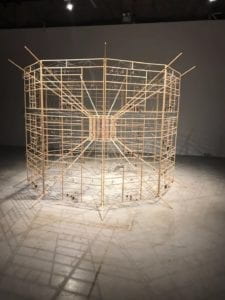The comparison between technology-based art pieces and non-technology based art pieces
After the field trip to the Chronus exhibition, I had a totally new understanding of art. For a long time in my life, I have never considered machines, or to say, those technological devices to be art. Since they are usually very rational and lack the visual beauty which the non-technology based art can show. During my experience of appreciating art pieces(though I nearly know nothing about them), I saw many famous pieces and sense some of their beauty but are confused about the most of them. The pieces which I can understand usually belong to realism and those I have no idea about is usually abstract. Here are some examples:
The Last Supper by Leonardo da Vinci

The Picture of shrimps by Qi Baishi
 Black Square by Kazimir Malevich
Black Square by Kazimir Malevich

As we can see, though we sometimes can not fully understand what the painter or the sculptor tries to convey, the non-technology based art pieces can still show us the direct visual impact through colors and shapes. And it doesn’t require the audience to have any background knowledge to feel the beauty of them from different levels. While seeing the technology-based art pieces, if one knows nothing about those components, it will be confused for him or her to understand and appreciate the work even with the help of the description of it. This is a picture of the inverted machine by Rechnender Raum. If I know nothing about technology, I will describe it as a sculpture constructed from sticks, strings, and little plumbs. But if I know more, I could probably understand the meaning from the description: “At the same time it is a full functional logic exact neural network, and a strict self-referentiality and ignorance to the viewer is realized.” After the field trip, though I did not understand most of the art pieces, I began to think about the beauty of those machines and components. From my perspective, the biggest difference between technology and none-technology based art is that the former requires more logic and background knowledge to appreciate and the more we know, the way we view and understand it will change. While the latter one requires more emotional feelings.

Online research
I saw more projects online and find these two to analyze:
Smile TV – It works only when you smile https://www.creativeapplications.net/maxmsp/smile-tv-works-only-when-you-smile/
Click Canvas
https://www.creativeapplications.net/member-submissions/click-canvas/
From my perspective, the Smile TV provides a successful interactive experience. Though the process of the whole interaction is simple, it is very clear and gives continuous feedback according to the changes of the user’s facial expression. When the user smile, the TV shows clear images. When the smile disappears, the images disappear. We can see from the video that the change of the expression and the TV is almost at the same time and it forms a loop when the user constantly changes facial expression. The reason why Click Canvas is less successful is that it only includes interaction every time the user press the button. If the user presses the button, the color of the button changed. The user can create an image they want by pressing buttons at different positions. The problem is that the whole process of creating an image is subjective which shows less interaction with the device.
My definition of interaction is a cyclic process that requires at least two objects (both animate and inanimate are accepted) individually has its input-analyze-output. Also, the whole process needs to be meaningful and forms a loop that allows the user to continually interact with it. Base on this, my midterm project successfully made a device that can serve the food to you when you place your phone at the appointed place and withdraw the food if you take your phone away to use. That is a loop the same as the Smile TV and according to Crawford, “the value of the interaction exits at the moment someone feels connections-engagement, entertainment and so on”(Crawford,4). But, be careful, interaction should be interesting but more importantly, it should focus more on the input-analyze-output part.
Work cited